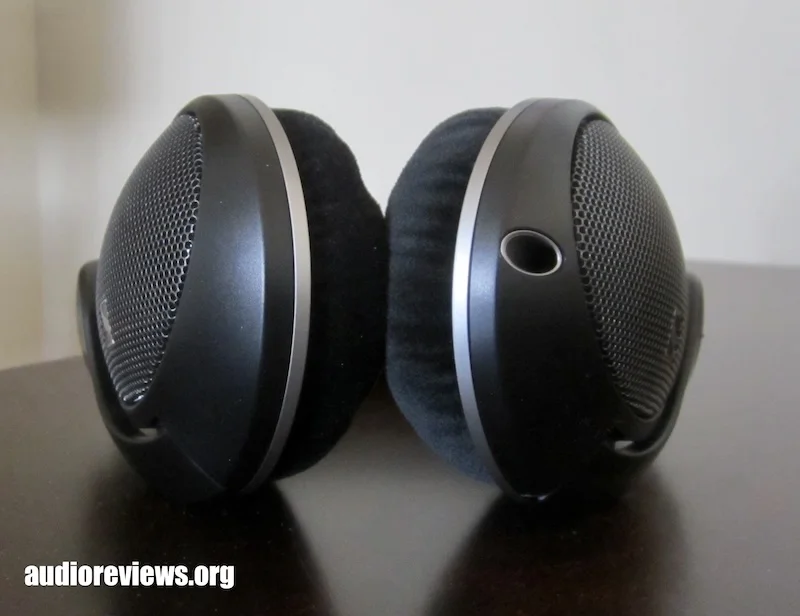Sennheiser HD 550 Headphone REVIEW – Wolf In Sheep’s Clothing
I thank Sennheiser for sending me their $299 USD HD 550 for review. I performed my listening tests with the black stock cable on single-ended audio circuits. The red cable on the title photo is the modular HC-6-B from Hart Audio, which I purchased for use with balanced audio circuits. Sennheiser also offers such a “balanced” cable.
The neutrally tuned open-back around-ear Sennheiser HD 550 are essentially a leaner-sounding version of the HD 600 with a stronger and tighter low end and a toned-down upper midrange. Their low weight and small caliper pressure make them very comfortable for me. A complete product.
PROS
- Homogenous, neutral sonic presentation
- Low weight and small caliper pressure make it extremely comfortable
CONS
- Soundstage could be wider and deeper
- Not the most exciting look
In this Article
Introduction
Sennheiser, one of Germany’s finest audio companies, have recently released a number of similarly priced headphone models that carry similar names (or rather numbers). Traditionally, the company features their HD 500 line (the famous HD 580 from 1993 come to mind), their classic HD 600 line (HD 600/650/6XX), and their reference HD 800 line. Sonic & build quality and pricing are correlated so that HD 800 series > HD 600 series > HD 500 series.
Recent additions comprise the HD 620S, HD 660S, the HD 505, and the current HD 550, to name but a few. Adding insult to injury, the regional Sennheiser websites are jungles. They make it very hard even for the experienced listener to find anything let alone the right model.
In order to minimize confusion, Sennheiser introduced a naming convention so that the potential buyer is aware of what expects them just by looking at the name. Have a look at it:
Like many audio brands, Sennheiser use an alphanumeric system for many of their products. With an 80 year anniversary on their heels, they have amassed an enormous catalog of product names….some of the rules they have established along the way have been bent as the markets and products evolve. Sennheiser have recently simplified the names to easier to classify their products. While not perfect (and not entirely retroactive) the company’s next few releases are a good demonstration of the new naming method.
The first letters classify the headphone at the widest part of the funnel: “HD” stands for Headphone, Dynamic, as it always has. IE is an In-Ear (dynamic), HE is Headphone Electrostatic, etc. This remains unchanged.
The next number (in this instance, “5”) places the headphone in a performance series: HD 500, 600, or 800..again, unchanged.
The numbers after that is where we are going to tighten things up.
x20 will be reserved for closed-back models (example: HD 820, HD 620S)
x50 and x00 will lean towards neutral tuning (example: HD 800S)
x60 will lean towards a warmer tuning (example: HD 660S2)
xx5 will, in most cases, indicate a retailer limited release in your market (example: HD 505)
Sennheiser’s back catalog is, naturally, full of exceptions.
The Sennheiser HD 550, according to the company’s convention, is a neutrally tuned, open-back headphone, that is performance/price wise below the HD 600 series. Spoiler alert, performance wise, the HD 550 is challenging the HD 600 series, and it beats it comfort wise.
Specifications Sennheiser HD 550
| Transducer principle | dynamic, open |
| Transducer size | 38 mm |
| Frequency response (speaker) | 6 Hz – 39,500 Hz |
| Sound pressure level (SPL) | 106.7 dB / 1 V RMS |
| Impedance | 150 Ω |
| Total harmonic distortion (THD) | < 0.2 % (1 kHz, 1 V) |
| Cable length | 1.8 m |
| Adapter | 3.5 mm stereo jack plug |
| Transducer principle | dynamic, open |
| Weight | 237 g |
| Connector | 3.5 mm stereo jack plug |
| Ear coupling | circumaural |
| Tested at | 299.95 USD / $399.95 CAD / 299.90 €. |
| Company’s Presentation | sennheiser-hearing-com |
| Product page |
Physical Things and Usability

The HD 550 come with a drawstring storage bag, a manual, and a 1.8 m detachable cable with a 3.5 mm plug [plus a 6.35 mm adapter] that is being connected via a lock mechanism to the left earpiece. The headphone is, like its siblings, easily taken apart and therefore user serviceable.
Replacement parts and a 4.4 mm balanced cable can be ordered from Sennheiser. The 38 mm transducers are manufactured in Ireland, the headphones are assembled in China.
The frame design is reminiscent of the classic 500 series, It is very similar to my “old” HD 598 from >10 years ago.
Like most Sennheiser headphones much of the frame and earcups are made of durable and rugged polycarbonate (“plastic”)….the company is certainly leading the competition in terms of material science. The earcups feature metal grilles.
The headband is enclosed in pleather with decent padding on its inner side. The clamp force is relatively small, much smaller that of my HD 600 and of the HD 620S I have reviewed. The HD 550 are also extremely light, and there is tons of space for my “flappers” inside the earcups.
These factors make the HD 550 very comfortable even for my big teutonic head. Comfort is frequently neglected when evaluating a headphone. But, EVERY single $$$$ headphone will be heavier than the HD 550’s 237 g. Very important for long listening sessions.



Tonality and Technicalities
Follow these links for some background information:
My tonal preference and testing practice
Upon a first listen, the HD 550 reminded me of my beloved HD 600. I then searched the internet for graphs that compare these two model. And yes, there are similarities: the HD 550 has more bass below 100 Hz, both are essentially identical from there to 2 kHz, the HD 550 is toned down between 2 and 4 kHz (the frequency segment that can be most irritating for the human ear) but a bit higher in the lower treble and lower in the upper treble compared to the HD 600.
The idea behind this tuning obviously was to remove the HD 600’s shrillness and to accentuate the bass. But graphs tell us only half the story. After all, there are 28 years of progress in driver development between the two models, which is one human generation. And, while graphs remain the same for all, everybody has a different hearing perception.
For my listening test, I must have swapped these two models tens of times around and connected them to pretty much every music source I have. The HD 550 sound so homogenous and balanced to my ears that I would like to relieve you now from my writeup and just send you to audition one.
Considering that the human ear hears the whole frequenciy spectrum in context makes it very difficult (and somewhat redundant) for particularly this headphone to break it down into details.
What strikes me first when listening to the HD 550 is its clean, tight, and well-defined low-end. In comparison, the HD 600’s low-end is thicker and “slower”. The HD 600’s lower midrange, that is vocals, picks up some richness from its bass which adds smoothness, whereas the HD 550’s lower midrange is leaner, cleaner, and sharper resulting in very good midrange clarity and transparency.
The HD 600’s low-end thickness also makes for a deeper soundstage, whereas the HD 550’s stage is wider, though not by much. Both headphones have a wonderful timbre and natural presentation. And both have a well-extended, well-resolving treble, which I do not find harsh in any way but rather sweet.
The HD 600 have a slightly better detail resolution in midrange and treble, a better imaging, and a better spatial reconstruction. The HD 550 have a harder beat and are overall better balanced across the frequency spectrum.
In summary, while both have a similar tonality, the HD 550’s presentation is more measured, leaner with a bit more sparkle on the top, but also less 3-dimensional, whereas the fuller sounding HD 600 have more “soul”, that is its charm listeners love while forgiving their technical shortcomings.
Concluding Remarks
The HD 550 is a HD 600 series headphone in a HD 500 series body….a wolf in sheep’s clothing…with some comfort added. Simply very good! One of the best review items that have come into my hands in the last 5 years, but also one of the hardest products to characterize.
We learn (in the Trumpian age): 6 is not always bigger than 5.
Until next time…keep on listening

DISCLAIMER
Our generic standard disclaimer.
You find an INDEX of our most relevant technical articles HERE.








